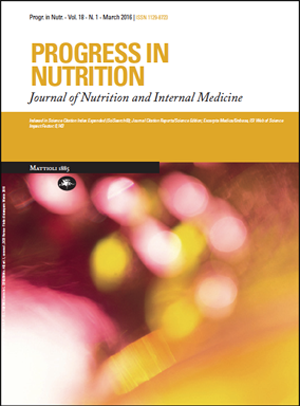The impact of nutritional risk screening 2002 and subjective global assessment upon prognosis for intensive care patients
Keywords:
Malnutrition, Intensive Care, Nutritional Risk Screening (NRS 2002), Subjective Global Assessment (SGD)Abstract
Aims: The assessment of nutritional status aims to specify individuals and communities that are malnourished or under malnutrition risk, to develop healthcare programs aimed at meeting society’s needs in the wake of the assessment. Subjective Global Assessment (SGA) and Nutritional Risk Screening (NRS) 2002 is assessed for intensive care patients, it turns out to be indicative of their prognosis simply and effectively. Methods: The age, weight, body mass index (BMI), APACHE II, SOFA score, biochemical parameters (albumin, prealbumin, total lymphocyte levels), triceps thickness from anthropometric measurements were recorded during the hospitalization process. The patients were classified as nutritionally risk (NRS2002 +) or nutritionally risk-free (NRS2002 -) after NRS2002 assessment. According to SGD, the patients were categorized as well-fed (SGD-A), slightly or moderately malnourished (SGD-B), and heavy malnourished (SGD-C). The nutritional changes in the patient were categorized as NRS2002 -/SGD A (good nutrition), NRS2002 +/SGD B (slight or moderate malnutrition), or NRS2002 -/SGD C (severe malnutrition). Results: It is found that 49,8% of the patients were in the well-fed group, 42,2% of them in the slightly-moderately malnourished group, and 8% of them in the heavy-malnourished group. While the rate of malnutrition increases as the patients’ age increases, and as their weight and BMI decrease, albumin, prealbumin, total lymphocyte, triceps skinfold thickness values decrease as malnutrition increases. For the patients with higher malnutrition rate, the duration of stay in the intensive care unit and mechanic ventilators and the mortality rate increase. Conclusions: We found that mortality increased with malnutrition. The nutritional status should be followed, and a treatment plan should be drawn up in critical care patients. Thus; SGA, NRS 2002 and other objective methods for assessing nutritional status with high sensitivity and specivity can be recommended for evaluation of critically ill patients.Downloads
Published
Issue
Section
License
This is an Open Access article distributed under the terms of the Creative Commons Attribution License (https://creativecommons.org/licenses/by-nc/4.0) which permits unrestricted use, distribution, and reproduction in any medium, provided the original work is properly cited.
Transfer of Copyright and Permission to Reproduce Parts of Published Papers.
Authors retain the copyright for their published work. No formal permission will be required to reproduce parts (tables or illustrations) of published papers, provided the source is quoted appropriately and reproduction has no commercial intent. Reproductions with commercial intent will require written permission and payment of royalties.

This work is licensed under a Creative Commons Attribution-NonCommercial 4.0 International License.


